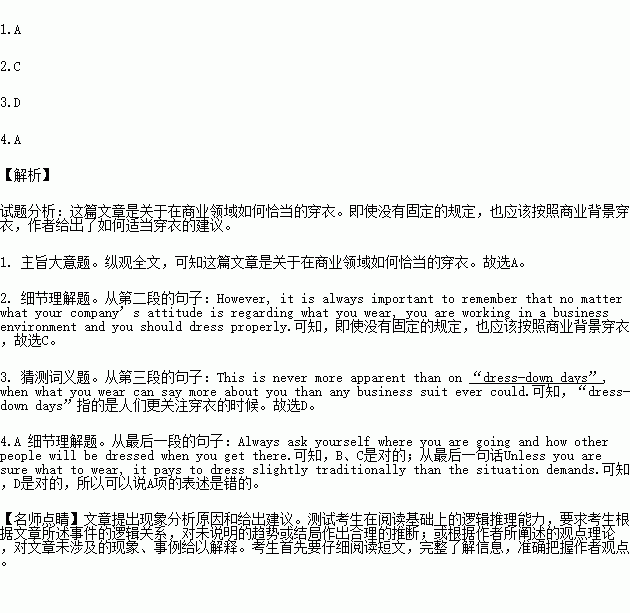题目内容
Being less than perfectly well-dressed in a business setting can result in a feeling of great discomfort that may well require treatment to eliminate. And the sad truth is that “clothing mismatches” on the job can ruin the day of the person who is wearing the inappropriate attire(着装)—and the people with whom he or she comes in contact.
Offices vary when it comes to dress codes. Some businesses have very high standards for their employees and set strict guidelines for office attire, while others maintain a more relaxed attitude. However, it is always important to remember that no matter what your company’s attitude is regarding what you wear, you are working in a business environment and you should dress properly. Certain items may be more appropriate for evening wear than for a business meeting, just as shorts and a T-shirt are better suited for the beach than for an office environment. Your attire should reflect both your environment and your position. A senior vice president has a different image to maintain than that of a secretary or sales assistant. Like it or not, you will be judged by your personal appearance.
This is never more apparent than on “dress-down days”, when what you wear can say more about you than any business suit ever could. In fact, people will pay more attention to what you wear on dress-down days than on “business professional ” days. Thus, when dressing in “business casual” clothes, try to put some good taste into your wardrobe choices, recognize that the “real” definition of business casual is to dress just one notch(等级) down from what you would normally wear of business-professional attire days.
Remember, there are borders between your career and our social life. You should dress one way for play and another way when you mean business. Always ask yourself where you are going and how other people will be dressed when you get there. Is the final destination the opera, the beach, or the office? Dress properly and you will discover the truth in the principle that clothes make the man—and the woman. When in doubt, always misjudge on the side of dressing slightly more traditionally than the situation demands.
1.What is the passage mainly about?
A. How to dress properly in a business setting.
B. A president of a company should dress differently from a secretary or sales assistant.
C. The differences between professional and casual dress.
D. Improper dress will make a person feel uncomfortable.
2.Which of the following statements is true?
A. Every company has strict rules regarding office dress.
B. You can wear whatever you like if your company doesn’t have standards for dressing.
C. You should dress according to the business setting even when there are no fixed rules.
D. In companies with relaxed rules on office dress, you can’t spot a manager among others.
3.Which statement best describes “dress-down days”?
A. We can’t judge a person’s taste by his clothes on dress-down days.
B. People’s clothes on dress-down days don’t receive much attention.
C. On dress-down days, you can wear whatever you like.
D. People are usually more careful about what they wear on dress-down days than on other occasions.
4.Which of the following is NOT the rule in the passage with regard to business dress?
A. For a business meeting and a concert, you should dress differently.
B. Remember to ask others for advice when you are not sure about what to dress.
C. Think about how other guests will wear if you are invited to a dinner.
D. Dress a bit traditionally if you are not sure about proper dress for a certain occasion.
 天天向上一本好卷系列答案
天天向上一本好卷系列答案 小学生10分钟应用题系列答案
小学生10分钟应用题系列答案
